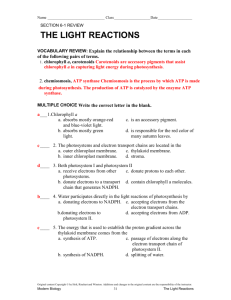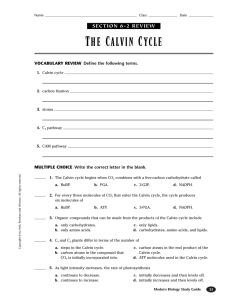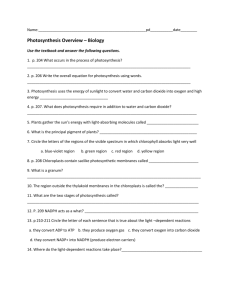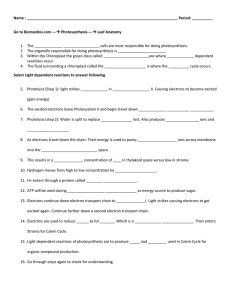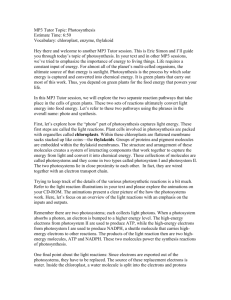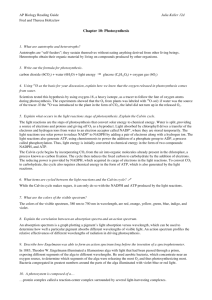6.1 & 6.2 Reviews
advertisement
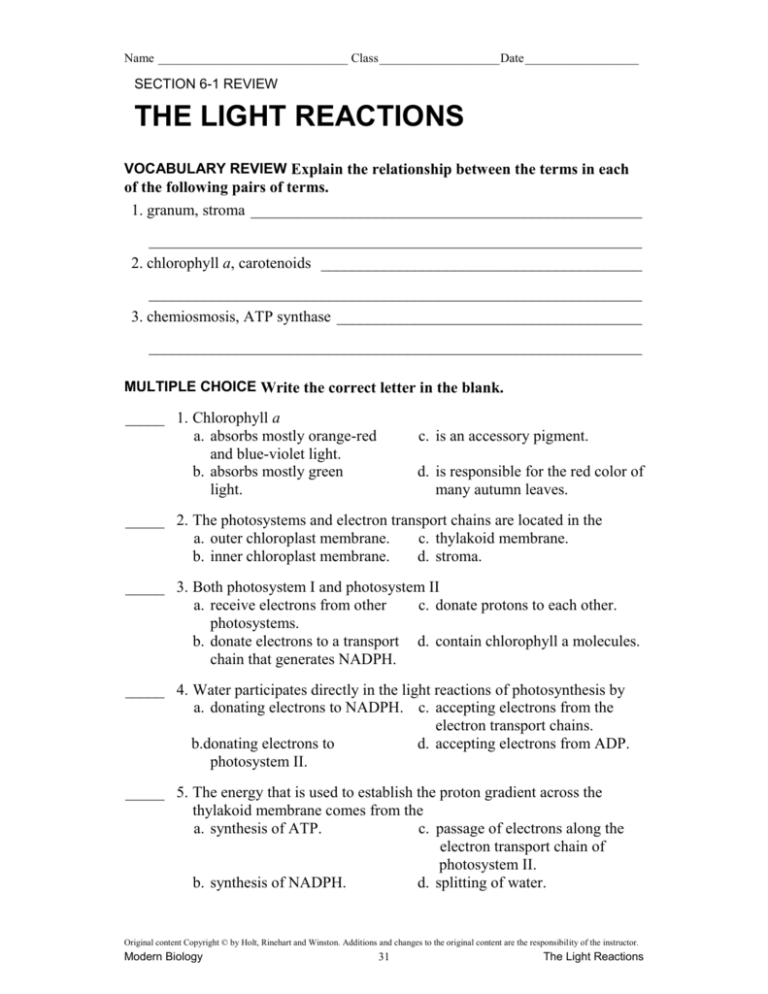
Name ______________________________ Class ___________________ Date __________________ SECTION 6-1 REVIEW THE LIGHT REACTIONS VOCABULARY REVIEW Explain the relationship between the terms in each of the following pairs of terms. 1. granum, stroma __________________________________________________ _______________________________________________________________ 2. chlorophyll a, carotenoids _________________________________________ _______________________________________________________________ 3. chemiosmosis, ATP synthase _______________________________________ _______________________________________________________________ MULTIPLE CHOICE Write the correct letter in the blank. _____ 1. Chlorophyll a a. absorbs mostly orange-red and blue-violet light. b. absorbs mostly green light. c. is an accessory pigment. d. is responsible for the red color of many autumn leaves. _____ 2. The photosystems and electron transport chains are located in the a. outer chloroplast membrane. c. thylakoid membrane. b. inner chloroplast membrane. d. stroma. _____ 3. Both photosystem I and photosystem II a. receive electrons from other c. donate protons to each other. photosystems. b. donate electrons to a transport d. contain chlorophyll a molecules. chain that generates NADPH. _____ 4. Water participates directly in the light reactions of photosynthesis by a. donating electrons to NADPH. c. accepting electrons from the electron transport chains. b.donating electrons to d. accepting electrons from ADP. photosystem II. _____ 5. The energy that is used to establish the proton gradient across the thylakoid membrane comes from the a. synthesis of ATP. c. passage of electrons along the electron transport chain of photosystem II. b. synthesis of NADPH. d. splitting of water. Original content Copyright © by Holt, Rinehart and Winston. Additions and changes to the original content are the responsibility of the instructor. Modern Biology 31 The Light Reactions Name ______________________________ Class ___________________ Date __________________ SHORT ANSWER Answer the questions in the space provided. 1. Why is photosynthesis referred to as a biochemical pathway? _____________ _______________________________________________________________ 2. How does the structure of a chloroplast enable it to build up a concentration gradient of protons? _______________________________________________________________ _______________________________________________________________ _______________________________________________________________ 3. What are the energy-carrying end products of the light harvesting reactions? _______________________________________________________________ 4. Explain the function of accessory pigments. ___________________________ _______________________________________________________________ _______________________________________________________________ 5. Critical Thinking Which photosystem—I or II—most likely evolved first? Explain your reasoning. _______________________________________________________________ _______________________________________________________________ _______________________________________________________________ STRUCTURES AND FUNCTIONS Label the substances represented by the letters a–d below. The diagram below summarizes the light reactions of photosynthesis. Original content Copyright © by Holt, Rinehart and Winston. Additions and changes to the original content are the responsibility of the instructor. Modern Biology 32 The Light Reactions Name ______________________________ Class ___________________ Date __________________ SECTION 6-2 REVIEW THE CALVIN CYCLE VOCABULARY REVIEW Define the following terms. 1. Calvin cycle ____________________________________________________ _______________________________________________________________ 2. carbon fixation __________________________________________________ _______________________________________________________________ 3. stoma _________________________________________________________ _______________________________________________________________ 4. C 4 pathway _____________________________________________________ _______________________________________________________________ 5. CAM pathway __________________________________________________ _______________________________________________________________ MULTIPLE CHOICE Write the correct letter in the blank. _____ 1. The Calvin cycle begins when CO2combines with a five-carbon carbohydrate called a. RuBP. b. PGA. c. 3-G3P. d. NADPH. _____ 2. For every three molecules of CO2 that enter the Calvin cycle, the cycle produces six molecules of a. RuBP. b. ATP. c. 3-PGA. d. NADPH. _____ 3. Organic compounds that can be made from the products of the Calvin cycle include a. only carbohydrates. c. only lipids. b. only amino acids. d. carbohydrates, amino acids, and lipids. _____ 4. C3 and C4 plants differ in terms of the number of a. steps in the Calvin c. carbon atoms in the end product cycle. of the Calvin cycle. b. carbon atoms in the compound d. ATP molecules used in the that CO2 is initially incorporated Calvin cycle. into. _____ 5. As light intensity increases, the rate of photosynthesis a. continues to c. initially decreases and then levels decrease. off. b. continues to d. initially increases and then levels increase. off. Original content Copyright © by Holt, Rinehart and Winston. Additions and changes to the original content are the responsibility of the instructor. Modern Biology 33 The Light Reactions Name ______________________________ Class ___________________ Date __________________ SHORT ANSWER Answer the questions in the space provided. 1. How many molecules of ATP and NADPH are used in a single turn of the Calvin cycle? _______________________________________________________________ 2. Using (CH2O) as the general formula for a carbohydrate, write the simplest overall equation for photosynthesis. __________________________________ 3. How do CAM plants differ from both C3 and C4 plants? __________________ _______________________________________________________________ 4. Why does the rate of photosynthesis increase, peak, and then decrease as temperature increases? _______________________________________________________________ _______________________________________________________________ _______________________________________________________________ 5. Critical Thinking Stomata can open and close in response to changes in the CO2 concentration inside the leaf. Would you expect stomata to open or close if the CO2 concentration decreased? Explain. ________________________________________________________ _______________________________________________________________ _______________________________________________________________ STRUCTURES AND FUNCTIONS In the blank spaces provided in the diagram, indicate the number of molecules of each substance that are involved when three CO2 molecules enter the cycle. The diagram below summarizes the Calvin cycle. Original content Copyright © by Holt, Rinehart and Winston. Additions and changes to the original content are the responsibility of the instructor. Modern Biology 34 The Light Reactions


